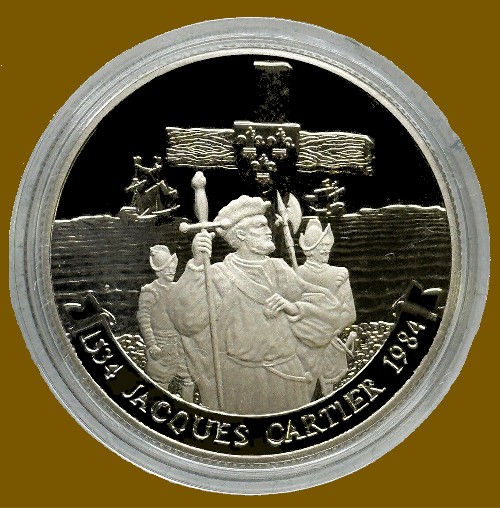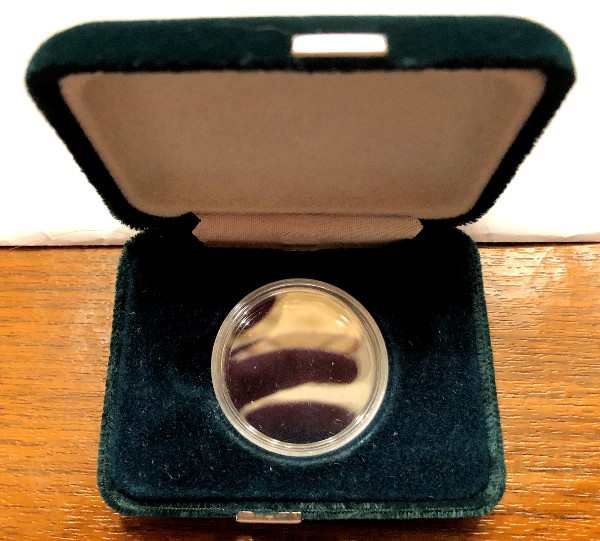Finishing my commemorative nickel dollar series up with a coin that fits into one of my favorite themes - Explorers!The 450th Anniversary of French explorer Jacques Cartier's landing on the Gaspe Peninsula of Quebec was marked with a commemorative nickel dollar issued as a circulation coin and as a Proof coin for collectors; the coin was released into circulation in June 1984. Cartier was born in Saint-Malo, France in 1491 and died there in 1557.
In 1533, King Francis I of France commissioned Cartier to explore North America in an attempt to locate mineral riches and find the fabled Northwest Passage to Asia. Francis I outfitted Cartier's expedition with two ships; Cartier arranged for 60 men to crew them. The First of his three voyages left France on April 20, 1534, and arrived off the coast of Newfoundland on May 10th. During this First Voyage, Cartier sailed around much of Newfoundland (minus its southern coast), throughout the Gulf of St. Lawrence, sighting Magdalen Island, Prince Edward Island and Anticosti Island. And, of course, landed on the Gaspe Peninsula.
Note 1: The local Huron-Iroquois used the word "kanata" (village) to refer to the village of Stadacona, which Cartier subsequently used to refer to entire area under the control of the village chief, Donnaconna. "Canada" was first used by mapmakers to refer to the area around the St. Lawrence River, but its use continued to expand and eventually evolved into the country's name and replaced "New France.")Note 2: Carter sailed to Canada on the behalf of France two more times - 1535-36 and 1541-42.Cartier's First Voyage to Canada Route with Landing at Gaspe (Image Credit: Jon Platek, CC BY-SA 3.0 https://creativecommons.org/licenses/by-sa/3.0, via Wikimedia Commons.
(Image Credit: Jon Platek, CC BY-SA 3.0 https://creativecommons.org/licenses/by-sa/3.0, via Wikimedia Commons.The dollar's obverse design presents the Arnold Machin portrait of Queen Elizabeth II. The coin's commemorative reverse depicts a scene of Cartier coming ashore in Gaspe. He is shown in the foreground with two others from his expedition and the cross he was to erect on Gaspe near the mouth of the York River (present-day names) in the background; rippling waters and the expedition's two sailing ships are also seen. Below the figures, curving along the coin's rim, is a ribbon inscribed "1534 JACQUES CARTIER 1984".
(Note: Cartier erected a cross at Saint-Servan, on the northern coast of the St. Lawrence River (across from present-day Newfoundland) prior to the cross at Gaspe - one purpose for them was to mark France's claim on the new lands.) Toronto-born Hector Greville designed the commemorative reverse, with the modeling of the design handled by the Mint's Victor Cole. The design was commissioned directly by the Mint vs. a nationwide, open competition.
1984 Mintage FiguresCirculation Coin: 6,141,503
Collector Coin: 87,776 [Cased Dollar, Proof]
The coin was available individually in circulation (at face value) and cased for $9.75. (Prices in Canadian Dollars) The 1984 Jacques Cartier circulation dollar was issued alongside a Voyageur dollar. The Voyageur dollar, rather than the Cartier dollar, was included in the annual Uncirculated Set, "Double Cent" Specimen Set and "Double Dollar" Prestige Set.
The Proof dollar was encapsulated and inserted into a green velvet tray inside of a rectangular, green, book-style case with a 3-D grey maple leaf on its lid (same as on 1982 Constitution dollar packaging). The case was placed in a green, plastic, two-piece outer box with the Mint's modern, stylized maple leaf logo on the outside of its top piece.
1984 Jacques Cartier Dollar 1984 Jacques Cartier Dollar - Clam Shell - Interior View
1984 Jacques Cartier Dollar - Clam Shell - Interior View 1984 Jacques Cartier Dollar - Outer Box
1984 Jacques Cartier Dollar - Outer Box
For other of my posts about commemorative coins and medals, including more Canadian Commemorative stories, see:
Commems Collection.


























